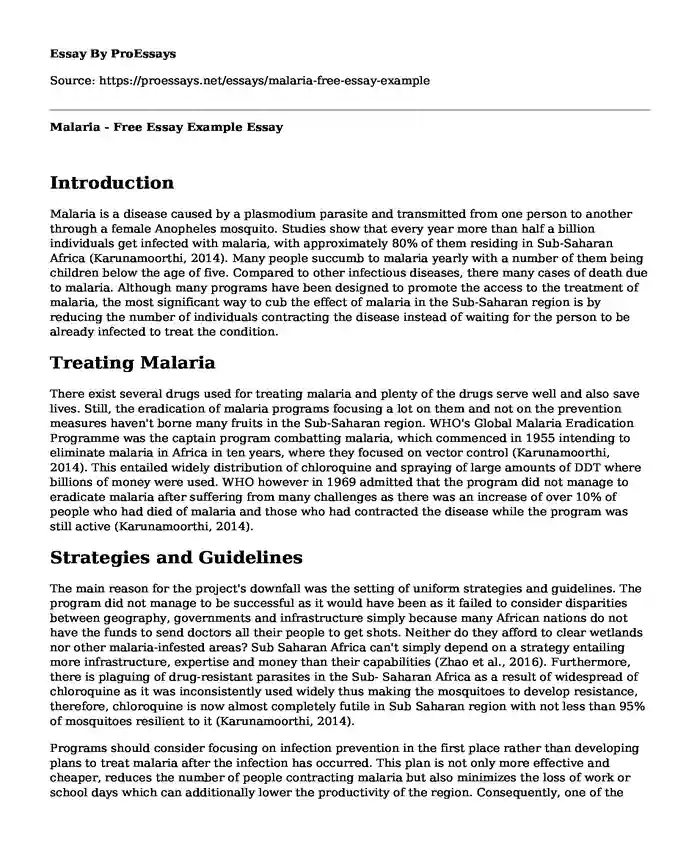Introduction
Malaria is a disease caused by a plasmodium parasite and transmitted from one person to another through a female Anopheles mosquito. Studies show that every year more than half a billion individuals get infected with malaria, with approximately 80% of them residing in Sub-Saharan Africa (Karunamoorthi, 2014). Many people succumb to malaria yearly with a number of them being children below the age of five. Compared to other infectious diseases, there many cases of death due to malaria. Although many programs have been designed to promote the access to the treatment of malaria, the most significant way to cub the effect of malaria in the Sub-Saharan region is by reducing the number of individuals contracting the disease instead of waiting for the person to be already infected to treat the condition.
Treating Malaria
There exist several drugs used for treating malaria and plenty of the drugs serve well and also save lives. Still, the eradication of malaria programs focusing a lot on them and not on the prevention measures haven't borne many fruits in the Sub-Saharan region. WHO's Global Malaria Eradication Programme was the captain program combatting malaria, which commenced in 1955 intending to eliminate malaria in Africa in ten years, where they focused on vector control (Karunamoorthi, 2014). This entailed widely distribution of chloroquine and spraying of large amounts of DDT where billions of money were used. WHO however in 1969 admitted that the program did not manage to eradicate malaria after suffering from many challenges as there was an increase of over 10% of people who had died of malaria and those who had contracted the disease while the program was still active (Karunamoorthi, 2014).
Strategies and Guidelines
The main reason for the project's downfall was the setting of uniform strategies and guidelines. The program did not manage to be successful as it would have been as it failed to consider disparities between geography, governments and infrastructure simply because many African nations do not have the funds to send doctors all their people to get shots. Neither do they afford to clear wetlands nor other malaria-infested areas? Sub Saharan Africa can't simply depend on a strategy entailing more infrastructure, expertise and money than their capabilities (Zhao et al., 2016). Furthermore, there is plaguing of drug-resistant parasites in the Sub- Saharan Africa as a result of widespread of chloroquine as it was inconsistently used widely thus making the mosquitoes to develop resistance, therefore, chloroquine is now almost completely futile in Sub Saharan region with not less than 95% of mosquitoes resilient to it (Karunamoorthi, 2014).
Programs should consider focusing on infection prevention in the first place rather than developing plans to treat malaria after the infection has occurred. This plan is not only more effective and cheaper, reduces the number of people contracting malaria but also minimizes the loss of work or school days which can additionally lower the productivity of the region. Consequently, one of the most effective and cheapest ways of preventing malaria is to implement insecticide-treated nets (ITNs) which will provide a protective barrier around the people or person utilizing them (Mahmoudi & Keshavarz, 2017).
Conclusion
Although untreated nets can still also help, those insecticide-treated nets are much more productive because they stop mosquitoes from biting people through the traps and they help in reducing mosquito populations in a community thus helping individuals who don't even own bed nets. Bed nets are also very effective because most mosquito bites occur while is sleeping, so bed nets would be able to reduce the number of transmissions during the night drastically. Transmission of malaria can be decreased by as much as 90% in areas where the use of ITNs is widespread (Moreno & Joyner, 2015). Because money is scarce in Sub Saharan Africa, the low cost is a big benefit and the main reason why the program is successful.
References
Karunamoorthi, K. (2014). Malaria vaccine: a future hope to curtail the global malaria burden. International journal of preventive medicine, 5(5), 529.
https://www.ncbi.nlm.nih.gov/pmc/articles/PMC4050672/
Mahmoudi, S., & Keshavarz, H. (2017). Efficacy of phase 3 trial of RTS, S/AS01 malaria vaccine: the need for an alternative development plan. Human vaccines & immunotherapeutics, 13(9), 2098-2101. https://www.tandfonline.com/doi/pdf/10.1080/21645515.2017.1295906
Moreno, A., & Joyner, C. (2015). Malaria vaccine clinical trials: what's on the horizon. Current opinion in immunology, 35, 98-106.
https://www.ncbi.nlm.nih.gov/pmc/articles/PMC4553069/
Zhao, X., Smith, D. L., & Tatem, A. J. (2016). Exploring the spatiotemporal drivers of malaria elimination in Europe. Malaria Journal, 15(1), 122.
https://link.springer.com/article/10.1186/s12936-016-1175-z.
Cite this page
Malaria - Free Essay Example. (2024, Jan 11). Retrieved from https://proessays.net/essays/malaria-free-essay-example
If you are the original author of this essay and no longer wish to have it published on the ProEssays website, please click below to request its removal:
- Coursework Example: Diet and Activities for an Overweight Patient with Osteoporosis
- Intuitive Eating Essay
- Registered Nurse: A Crucial Cog in Improving Healthcare Environments - Research Paper
- COVID-19: Global Outbreak From China to Antarctica - Essay Sample
- Essay on Learning Disabilities: A Risk for Bullying and Challenges for Identification
- Tonsillectomy: Best Practices for Recurrent Infections in Children - Essay Sample
- Essay Example on The Commodification of Body Organs: How Technology Transformed Healthcare







